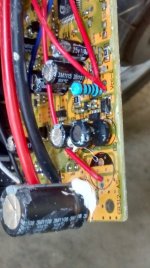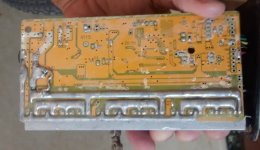StudEbiker said:
I was right at the top of a very big climb here in town. I had ridden up slowly and tried to keep watts below 1000 to take it easy on the motor. I had done the climb earlier in the week successfully using the same technique. Literally as I was at the top and about to put my foot down to stop, I heard a soft pffft sound and I lost the power to the motor. The CA was still displaying, but absolutely no power. Controller was very warm when I touched it but not so hot I couldn't keep my hand on it. That's about all I can tell you as far as how it failed.
I can't help you with the repair, other than to say that I've never seen a repaired controller end up a durable controller afterward.
What I can help with is the simple fact that going as slow as possible up a steep hill is the most torturous thing you can do to your system, and it's even more torturous on a controller run near its limits.
The reason is because despite the low power to climb at low speed, the controller must send very high phase current to the motor to create that power. Power in is battery current X voltage like we see reported by the CA, however, the power produced by the motor is rpm X torque. With rpm so low the controller sends a low voltage signal to the controller, simplistically stated as rpm/Kv, so the torque required is quite high. Torque is created by
phase current not battery current, and those high phase currents sent as short spike of high current at the PWM frequency are very hard on the controller, because they're happening in simplistic terms at the phase current limits of the controller. That's my biggest problem with the often copied and shared phase current to battery current ratio of 2.5-1 or higher. That kind of setting is only marginally appropriate for people living on flat terrain and don't do repetitive stop start accelerations like people who don't know better tend to do, those who get stuck in stop-n-go traffic are similarly at risk.
That doesn't mean you must artificially limit performance, and even with horrible current limit settings you can avoid much of the risk by charging at hills. For the mountainous terrain around where I live, I learned that with my bikes, that as long as I maintained near 50% of top speed while climbing any incline regardless of throttle position that my system stayed out of the danger zone. All my ebikes at the time topped out at about 60mph, and I got very anxious any time I got caught behind slow trucks up a significant grade. If I couldn't quickly pass then a number of times I pulled over and waiting for a break in traffic.
FWIW the limits I applied to my system aren't something to follow, and controller temp isn't always a hard guide either. The thing to understand is how dangerous partial throttle can be for your system, because failures can sneak on you unexpectedly. I blew a couple grand worth of cheap controllers to develop a reasonable understanding of things to avoid. That came into focus in late 2010, once the real electronics experts started teaching us what happens in terms of phase vs battery current. Since then I've only had 1 controller failure other than supposedly new and tested controllers that were bad out of the box, and the one failure resulted from being told that a controller had regen that turned out to be plug braking. That controller failure occurred the first time I grabbed a handfull of regen brake continuously from 60mph down to a sharp 90° turn.
The low speed issue is so big, that I've seen 2 controllers blow on flat ground at speeds below 5mph. The one that happened to me was on a road so bumpy that I felt that speed was appropriate. The bumps caused my wrist to repeatedly pulse the throttle, and while there wasn't any significant surging of the bike or change in speed, the pulsing spikes of phase current were noticed by the controller in a deathly way. The other time was my sub 100lb daughter riding very cautiously in the flat grassy park on her first ebike ride. She repeatedly pulsed the throttle to ride along very slowly for just a few minutes until the controller sizzled and popped.






